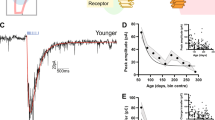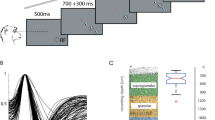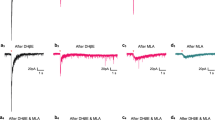Abstract
Little is known about acetylcholine (ACh) modulation of central visual processing in humans. Receptor densities in visual brain regions are differentially distributed suggesting that receptor subtypes have different functions. Using PET, we have previously described the brain regions activated by a simple pattern-flash stimulus in healthy elderly subjects. To evaluate muscarinic and nicotinic contributions to ACh modulation of visual processing, we scanned elderly subjects watching the pattern-flash stimulus during no drug, during physostigmine augmentation, and during scopolamine antagonism of physostigmine's action. These manipulations of ACh significantly altered regional cerebral blood flow (rCBF) in brain regions activated by the task. The pattern of rCBF values across drug conditions suggested that muscarinic and nicotinic effects were dissociated. Muscarinic action predominated in striate cortex (Brodmann Area, BA 17) and lateral visual association areas (BA 18, 19), while nicotinic action predominated in the thalamus and inferior parietal regions (BA 39/40). Both muscarinic and nicotinic actions increased rCBF in some regions while decreasing it in others. A parsimonious reconciliation of these results with functional anatomy suggests that muscarinic action modulates visual attribute processing, while nicotinic action modulates arousal and selective attention to the visual task.
Similar content being viewed by others

Log in or create a free account to read this content
Gain free access to this article, as well as selected content from this journal and more on nature.com
or
References
Arneric SP . (1989): Basal forebrain neurons modulate cortical cerebral blood flow: increases by nicotinic cholinergic mechanism. J Cereb Blood Flow Metab 9: S502
Bahro M, Molchan SE, Sunderland T, Herscovitch P, Schreurs BG . (1999): The effects of scopolamine on changes in regional cerebral blood flow during classical conditioning of the human eyeblink response. Neuropsychobiology 39: 187–195
Barefoot HC, Baker HF, Ridley RM . (2000): Synergistic effects of unilateral immunolesions of the cholinergic projections from the basal forebrain and contralateral ablations of the inferotemporal cortex and hippocampus in monkeys. Neuroscience 98: 243–251
Biesold D, Inanami O, Sato A, Sato Y . (1989): Stimulation of the nucleus basalis of Meynert increases cerebral cortical blood flow in rats. Neurosci Lett 98: 39–44
Buschke H, Fuld PA . (1974): Evaluating storage, retention, and retrieval in disordered memory and learning. Neurology 24: 1019–1025
Carson RE, Berg GW, Finn RD, Patlak CS, Daube-Witherspoon ME, Stein SD, Simpson NR, Green MV, Larson SM . (1987): Tomographic measurement of LCBF with high-resolution PET and H215O: comparison of methods. J Cereb Blood Flow Metab 7
Clarke PB . (1993): Nicotinic receptors in mammalian brain: localization and relation to cholinergic innervation. Prog Brain Res 98: 77–83
Cohen RM, Gross M, Semple WE, Nordahl TE, Sunderland T . (1994): The metabolic brain pattern of young subjects given scopolamine. Exp Brain Res 100: 133–143.
Court J, Perry E . (1995): Distribution of nicotinic receptors in the CNS. In Stone TW (ed), CNS Neurotransmitters and Neuromodulators: Acetylcholine. London, CRC Press, pp 85–104
Cymerman U, Palacios JM, Cortes R, Skangiel-Kramska J . (1987): Autoradiographic localization of muscarinic cholinergic receptors in visual areas of cat brain: variations in sensitivity of N-[3H]methylscopolamine binding sites to carbachol and pirenzepine. Neurosci Lett 81: 13–18
Desimone R, Ungerleider LG . (1989): Neural mechanisms of visual processing in monkeys. In Goodglass H, Damasio AR (eds), Handbook of Neuropsychology. Amsterdam, Elsevier, pp 267–300
Federighi ET . (1959): Extended tables of the percentage points of Student's t-distribution. J Am Stat Assoc 54: 683–688
Felleman DJ, Van Essen DC . (1991): Distributed hierarchical processing in the primate cerebral cortex. Cereb Cortex 1: 1–47
Fibiger HC, Vincent SR . (1987): Anatomy of central cholinergic neurons. New York, Raven Press
Friston KJ, Worsley KJ, Frackowiak RSR, Mazziotta JC, Evans AC . (1994): Assessing the significance of focal activations using their spatial extent. Human Brain Mapping 1: 210–220
Geula G, Mesulam MM . (1994): Cholinergic systems and related neuropathological predilection patterns in Alzheimer Disease. In Terry RD, Katzman R, Bick KL (eds), Alzheimer Disease. New York, Raven, pp 263–291
Grady CL, Haxby JV, Horwitz B, Schapiro MB, Ungerleider LG, Mishkin M, Carson RE, Herscovitch P, Rapoport SI . (1990): Changes in regional cerebral blood flow (rCBF) demonstrate separate visual pathways for object discrimination and spatial location. J Clin Exp Neuropsychol 12: 93
Grasby PM, Frith CD, Paulesu E, Friston KJ, Frackowiak RS, Dolan RJ . (1995): The effect of the muscarinic antagonist scopolamine on regional cerebral blood flow during performance of a memory task. Exp Brain Res 104: 337–348
Holden JE, Gatley SJ, Hichwa RD, Ip WR, Shaughnessy WJ, Nickles RJ, Polycn RE . (1981): Cerebral blood flow using PET measurements of fluoromethane kinetics. J Nucl Med 22: 1084–1088
Jeuptner M, Weiller C . (1995): Review: Does measurement of regional cerebral blood flow reflect synaptic activity? Implications for PET and fMRI. NeuroImage 2: 148–156
Kelly JP . (1991): The neural basis of perception and movement. In Kandel ER, Schwartz JH, Jessel TM (eds), Principles of neural science, Third Edition. New York, Elsevier, pp 283–295
Kubo T, Fukuda K, Mikami A, Maeda A, Takahashi H, Mishina M, Haga T, Haga K, Ichiyama A, Kangawa K, Kojima M, Matsuo H, Hirose T, Numa S . (1986): Cloning, sequencing and expression of complementary DNA encoding the muscarinic acetylcholine receptor. Nature 323: 411–416
Livingstone MS, Hubel DH . (1987): Psychophysical evidence for separate channels for the perception of form, color, movement and depth. J Neurosci 7: 3416–3468
London ED, Dam M, Fanelli RJ . (1988): Nicotine enhances cerebral glucose utilization in central components of the rat visual system. Brain Res Bull 20: 381–385
Lukas RJ, Changeux JP, Le Novere N, Albuquerque EX, Balfour DJ, Berg DK, Bertrand D, Chiappinelli VA, Clarke PB, Collins AC, Dani JA, Grady SR, Kellar KJ, Lindstrom JM, Marks MJ, Quik M, Taylor PW, Wonnacott S . (1999): International Union of Pharmacology. XX. Current status of the nomenclature for nicotinic acetylcholine receptors and their subunits. Pharmacol Rev 51: 397–401
Martinez-Murillo R, Rodrigo J . (1995): The localization of cholinergic neurons and markers in the CNS. In Stone TW (ed), CNS neurotransmitters and neuromodulators: Acetylcholine. London, CRC Press, 1–36
Mash DC, White WF, Mesulam MM . (1988): Distribution of muscarinic receptor subtypes within architectonic subregions of the primate cerebral cortex. J Comp Neurol 278: 265–274
Mason C, Kandel ER . (1991): Central visual pathways. In Kandel ER, Schwartz JH, Jessel TM (eds), Principles of neural science, Third Edition. New York, Elsevier, pp 421–439
McCormick D, Prince DA . (1985): Two types of muscarinic response to acetylcholine in mammalian cortical neurons. Proc Natl Acad Sci 82: 6344–6348
Mentis MJ, Alexander GE, Grady CL, Horwitz B, (1996a): On analyzing and interpreting PET activation data in the presence of significant and biologically meaningful group global mean differences. Human Brain Mapping, 2nd International Conference on Functional Mapping of the Human Brain. Boston, Academic Press
Mentis MJ, Alexander GE, Grady CL, Horwitz B, Krasuski J, Pietrini P, Strassburger T, Hampel H, Schapiro MB, Rapoport SI . (1997): Frequency variation of a pattern-flash visual stimulus during PET differentially activates brain from striate through frontal cortex. Neuroimage 5: 116–128
Mentis MJ, Alexander GE, Krasuski J, Pietrini P, Furey ML, Schapiro MB, Rapoport SI . (1998): Increasing required neural response to expose abnormal brain function in mild versus moderate or severe Alzheimer's disease: PET study using parametric visual stimulation. Am J Psychiatry 155: 785–794
Mentis MJ, Horwitz B, Grady CL, Alexander GE, VanMeter JW, Maisog JM, Pietrini P, Schapiro MB, Rapoport SI . (1996b): Visual cortical dysfunction in Alzheimer's disease evaluated with a temporally graded “stress test” during PET. Am J Psychiatry 153: 32–40
Muller CM, Singer W . (1989): Acetylcholine-induced inhibition in the cat visual cortex is mediated by a GABAergic mechanism. Brain Research 487: 335–342
Paterson D, Nordberg A . (2000): Neuronal nicotinic receptors in the human brain. Prog Neurobiol 61: 75–111
Paulson E, (1942): An approximate normalization of the Analysis of Variance distribution. Ann Math Statist
Perry EK, Smith CJ, Perry RH, Whitford C, Johnson M, Birdsall NJ . (1989): Regional distribution of muscarinic and nicotinic cholinergic receptor binding activities in the human brain. Journal of Chemical Neuroanatomy 2: 189–199
Posner MI, Dehaene S . (1994): Attentional networks. Trends Neurosci 17: 75–79
Robner S, Schliebs R . (1995): Distribution of Muscarinic Acetylcholine Receptors in the CNS. In Stone TW (ed), CNS neurotransmitters and Neuromodulators: Acetylcholine. London, CRC Press, 67–82
Rosier A-M, Cornette L, Dupont P, Bormans G, Mortelmans L, Orban GA . (1999): Regional brain activity during shape recognition impaired by a scopolamine channenge to encoding. Eur J Neurosci 11: 3701–3714
Sato A, Sato Y . (1995): Cholinergic neural regulation of regional cerebral blood flow. Alzheimer Disease and associated disorders 9: 28–38
Sato H, Hagihara K, Tsumoto T . (1987a): Effects of cholinergic depletion on neuron activities in the cat visual cortex. Journal of Neurophysiology 58: 781–793
Sato H, Hata Y, Masui H, Tsumoto T . (1987b): A functional role of cholinergic innervation to neurons in the cat visual cortex. Journal of Neurophysiology 58: 765–780
Schliebs R, Rossner S, Kumar A, Bigl V . (1994): Muscarinic acetylcholine receptor subtypes in rat visual cortex—a comparative study using quantitative receptor autoradiography and in situ hybridization. Indian J Exp Biol 32: 25–30
Sillito AM, Kemp JA . (1983): Cholinergic modulation of the functional organization of the cat visual cortex. Brain Research 289: 143–155
Sillito AM, Salt TE, Kemp JA . (1985): Modulatory and inhibitory processes in the visual cortex. Vision Res 25: 375–381
Spurden DP, Court JA, Lloyd S, Oakley A, Perry R, Pearson C, Pullen RG, Perry EK . (1997): Nicotinic receptor distribution in the human thalamus: autoradiographical localization of [3H]nicotine and [125I] alpha-bungarotoxin binding. J Chem Neuroanat 13: 105–113
Talairach J, Tournoux P . (1988): Co-planar stereotaxic atlas of the human brain. New York, Thieme Medical Publishers, Inc.
Watson M, Vickrow TW, Roeske WR, Yamamura HI . (1984): Subclassification of muscarinic receptors based upon the selective antagonist pirenzepine. Trends Pharmacol Sci Febr. Suppl 9
Wecker L, Yu ZJ . (1995): Function of nicotinic receptors in the CNS. In Stone TW (ed), CNS neurotransmitters and neuromodulators: Acetylcholine. London, CRC Press, pp 105–114
Winer BJ, Brown DR, Michels KM . (1991): Statistical Principles in Experimental Design. New York, McGraw-Hill
Woods RP, Grafton ST, Watson JD, Sicotte NL, Mazziotta JC . (1998): Automated image registration: II. Intersubject validation of linear and nonlinear models. J Comput Assist Tomogr 22: 153–165
Author information
Authors and Affiliations
Corresponding author
Rights and permissions
About this article
Cite this article
Mentis, M., Sunderland, T., Lai, J. et al. Muscarinic Versus Nicotinic Modulation of a Visual Task: A PET Study Using Drug Probes. Neuropsychopharmacol 25, 555–564 (2001). https://doi.org/10.1016/S0893-133X(01)00264-0
Received:
Revised:
Accepted:
Published:
Issue date:
DOI: https://doi.org/10.1016/S0893-133X(01)00264-0
Keywords
This article is cited by
-
CHRM2 Genotype Affects Inhibitory Control Mechanisms During Cognitive Flexibility
Molecular Neurobiology (2019)
-
Prompt but inefficient: nicotine differentially modulates discrete components of attention
Psychopharmacology (2011)
-
Psychoactive Drugs and Pilot Performance: A Comparison of Nicotine, Donepezil, and Alcohol Effects
Neuropsychopharmacology (2003)
-
Coupled reductions in brain oxidative phosphorylation and synaptic function can be quantified and staged in the course of Alzheimer disease
Neurotoxicity Research (2003)


